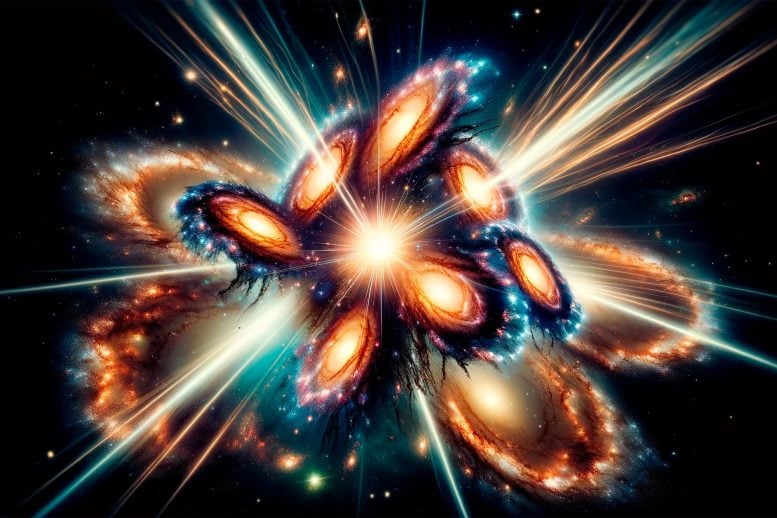
Astronomers have traced the most powerful and distant fast radio burst (FRB) to a rare cluster of interacting galaxies, challenging existing models of FRB origins and suggesting a connection to dense galactic environments. (Artist’s concept.) Credit: SciTechDaily.com
Hubble Space Telescope reveals curious birthplace of record-breaking blast.
- Fast radio burst (FRB) is the most powerful, most distant to date
- Astronomers find FRB originated not in one galaxy but a group of galaxies on the path to a possible merger
In the summer of 2022, astronomers detected the most powerful fast radio burst (FRB) ever observed. And coming from a location that dates halfway back to the Big Bang, it also was the farthest known FRB spotted to date.
Now, astronomers led by Northwestern University have pinpointed the extraordinary object’s birthplace — and it’s rather curious, indeed.
Using images from NASA’s Hubble Space Telescope, the researchers traced the FRB back to not one galaxy but a group of at least seven galaxies. The galaxies in the collection appear to be interacting with one another — perhaps even on the path to a potential merger. Such groups of galaxies are rare and possibly led to conditions that triggered the FRB.
The unexpected finding might challenge scientific models of how FRBs are produced and what produces them.
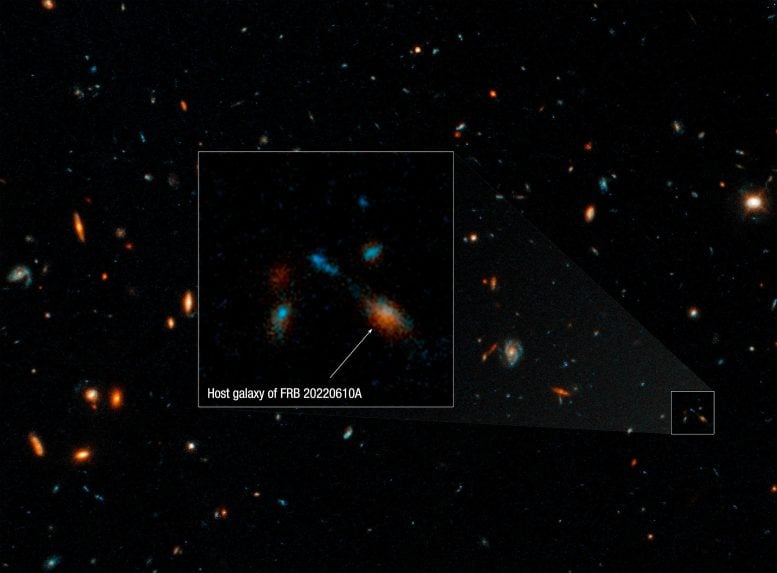
A Hubble Space Telescope image of the host galaxy of an exceptionally powerful fast radio burst, FRB 20220610A. Hubble’s sensitivity and sharpness reveals a compact group of multiple galaxies that may be in the process of merging. They existed when the universe was only 5 billion years old. FRB 20220610A was first detected on June 10, 2022, by the Australian Square Kilometer Array Pathfinder (ASKAP) radio telescope in Western Australia. The European Southern Observatory’s Very Large Telescope in Chile confirmed that the FRB came from a distant place. Credit: NASA, ESA, STScI, Alexa Gordon (Northwestern)
“Without the Hubble’s imaging, it would still remain a mystery as to whether this FRB originated from one monolithic galaxy or from some type of interacting system,” said Northwestern’s Alexa Gordon, who led the study. “It’s these types of environments — these weird ones — that drive us toward a better understanding of the mystery of FRBs.”
Gordon presented this research during the 243rd meeting of the American Astronomical Society in New Orleans, Louisiana. “Revealing the Environment of the Most Distant Fast Radio Burst with the Hubble Space Telescope” on January 9 as a part of a session on “High-Energy Phenomena and Their Origins.”
Gordon is a graduate student in astronomy at Northwestern’s Weinberg College of Arts and Sciences, where she is advised by study co-author Wen-fai Fong, an associate professor of physics and astronomy. Fong and Gordon also are members of the Center for Interdisciplinary Exploration and Research in Astrophysics (CIERA).
Birth From a Blob?
Flaring up and disappearing within milliseconds, FRBs are brief, powerful radio blasts that generate more energy in one quick burst than our sun emits in an entire year. And the record-breaking FRB (dubbed FRB 20220610A) was even more extreme than its predecessors.
Not only was it four times more energetic than closer FRBs, it also clocked in as the most distant FRB yet discovered. When FRB 20220610A originated, the universe was just 5 billion years old. (For comparison, the universe is now 13.8 billion years old.)
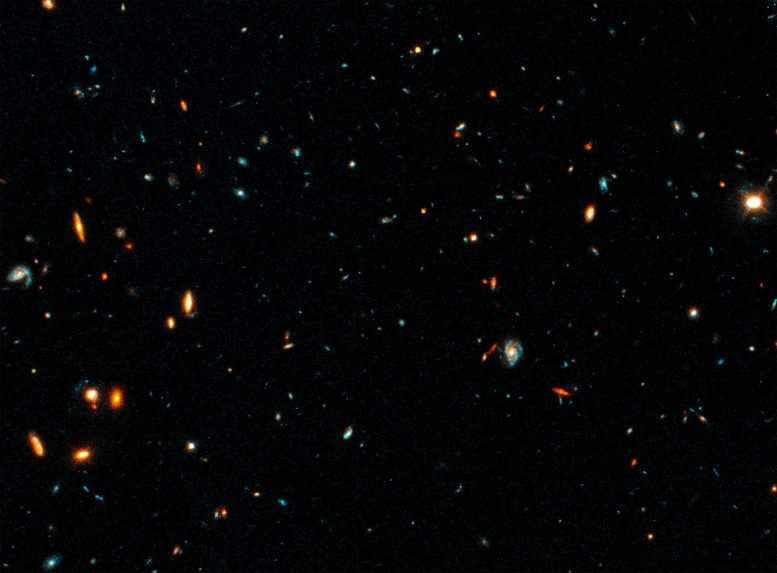
A Hubble Space Telescope image of the host galaxy of an exceptionally powerful fast radio burst, FRB 20220610A. Hubble’s sensitivity and sharpness reveals a compact group of multiple galaxies that may be in the process of merging. They existed when the universe was only 5 billion years old. FRB 20220610A was first detected on June 10, 2022, by the Australian Square Kilometer Array Pathfinder (ASKAP) radio telescope in Western Australia. The European Southern Observatory’s Very Large Telescope in Chile confirmed that the FRB came from a distant place. Credit: NASA, ESA, STScI, Alexa Gordon (Northwestern)
In early observations, the burst appeared to have originated near an unidentifiable, amorphous blob, which astronomers initially thought was either a single, irregular galaxy or a group of three distant galaxies. But, in a new twist, the Hubble’s sharp images now suggest the blob might be as least as many as seven galaxies in incredibly close proximity to one another. In fact, the galaxies are so close to one another that they could all fit inside our own Milky Way.
“There are some signs that the group members are ‘interacting,’” Fong said. “In other words, they could be trading materials or possibly on a path to merging. These groups of galaxies (called compact groups) are incredibly rare environments in the universe and are the densest galaxy-scale structures we know of.”
“This interaction could trigger bursts of star formation,” Gordon said. “That might indicate that the progenitor of FRB 20220610A is associated with a fairly recent population of stars which matches what we’ve learned from other FRBs.”
“Despite hundreds of FRB events discovered to date, only a fraction of those have been pinpointed to their host galaxies,” said study co-author Yuxin (Vic) Dong, an NSF Graduate Research, astronomy Ph.D. student in Fong’s lab and member of CIERA. “Within that small fraction, only a few came from a dense galactic environment, but none have ever been seen in such a compact group. So, its birthplace is truly rare.”
Enigmatic Explosions
Although astronomers have uncovered up to 1,000 FRBs since first discovering them in 2007, the sources behind the blinding flashes remain stubbornly uncertain. While astronomers have yet to reach a consensus on the possible mechanisms behind FRBs, they generally agree that FRBs must involve a compact object, such as a black hole or neutron star.
By revealing the true nature of FRBs, astronomers not only could learn about the mysterious phenomena but also about the true nature of the universe itself. When radio waves from FRBs finally meet our telescopes, they have traveled for billions of years from the distant, early universe. During this cross-universe odyssey, they interact with material along the way.
“Radio waves, in particular, are sensitive to any intervening material along the line of sight — from the FRB location to us,” Fong said. “That means the waves have to travel through any cloud of material around the FRB site, through its host galaxy, across the universe, and finally through the Milky Way. From a time delay in the FRB signal itself, we can measure the sum of all of these contributions.”
To continue to probe FRBs and their origins, astronomers need to detect and study more of them. And with technology continually becoming more sensitive, Gordon says more detections — potentially even capturing incredibly faint FRBs — are right around the corner.
“With a larger sample of distant FRBs, we can begin to study the evolution of FRBs and their host properties by connecting them to more nearby ones and perhaps even start to identify more strange populations,” Dong said.
“In the near future, FRB experiments will increase their sensitivity, leading to an unprecedented rate in the number of FRBs detected at these distances,” Gordon said. “Astronomers will soon learn just how special the environment of this FRB was.”
Reference: “A fast radio burst in a compact galaxy group at z ~ 1” by Alexa C. Gordon, Wen-fai Fong, Sunil Simha, Yuxin Dong, Charles D. Kilpatrick, Adam T. Deller, Stuart D. Ryder, Tarraneh Eftekhari, Marcin Glowacki, Lachlan Marnoch, August R. Muller, Anya E. Nugent, Antonella Palmese, J. Xavier Prochaska, Marc Rafelski, Ryan M. Shannon and Nicolas Tejos, 17 November 2023, Astrophysics > Astrophysics of Galaxies.
arXiv:2311.10815
The study was supported by the National Science Foundation (award numbers AST-1909358, AST-2047919 and AST-2308182), the David and Lucile Packard Foundation, the Alfred P. Sloan Foundation, the Research Corporation for Science Advancement and NASA (award number GO-17277). Astronomers first detected FRB 20220610A with the Australian Square Kilometer Array Pathfinder radio telescope in Western Australia and then confirmed its origin with the European Southern Observatory’s Very Large Telescope in Chile.

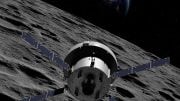

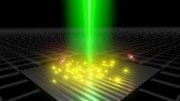

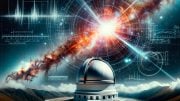

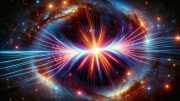
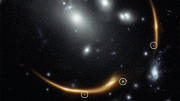
Isn’t this an opportunity [necessity] for viewing with the JWT ?
From my back-of-the-sticky-note calculations (the front side is already used), the JWST might not be usable for full-spectrum visual light analyses of objects that “close”. I could be wrong. I think the blue light from those galaxies is on the edge of not being red-shifted enough to be accurately detected by the JWST. Of course, longer wavelengths are certainly in play, and most of the light spectrum might be as well.
Another AAS 243 presentation concerned the prevalence of spiral galaxies as hosts for nearby FRBs. That may (small statistics) imply a major FRB channel is core-collapse supernova since they occur in massive, young stars of the nearby universe spiral galaxy star formation. (While that doesn’t explain FRB repeaters, which more likely are the already accepted magnetar formation channel.)
Now a star forming “odd ” cluster may still use that channel despite being located further away. Or not.